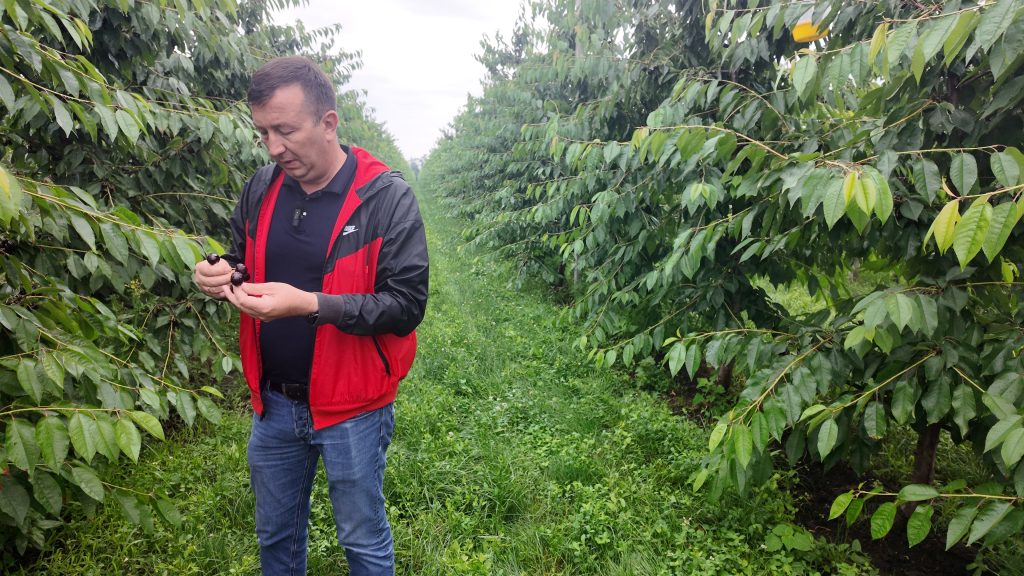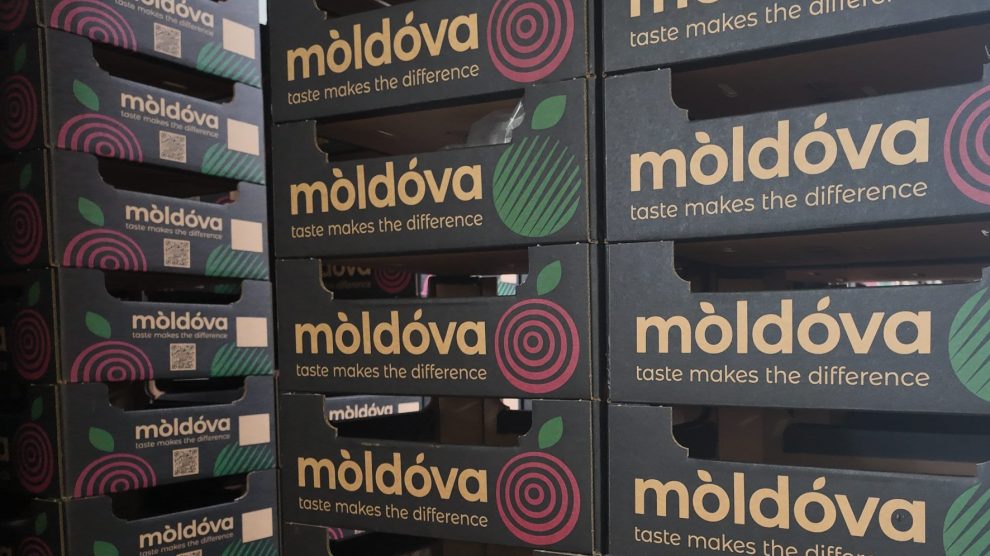Consumers in the European Union are increasingly seeing Moldovan labels on their fruit, as the country pivots away from the Russian market.
This summer, a heatwave has been suffocating Moldova, where agriculture is an important source of income. Almost everyone has been complaining about the unpredictable weather—for there has been rain too, a great deal of it.
“Some 300 millimetres of rain in six months, not counting snow! Two years ago, we had 250 millimetres in a year,” says fruit producer Ion Tulei, worried.
He shows us his cherry orchard in southern Moldova, near the Ukrainian border, only 80 kilometres from Odessa. His company Farmprod cultivates 50 hectares of apples, 28 hectares of cherries, and 27 hectares of plums, along with peaches, table grapes, and apricots.
- ‘Now is the time to invest in Moldova’
- How to build a unicorn from a small village?
- Will pro-Russian opposition parties derail Moldova’s EU accession?
We meet him in the middle of the summer, the peak time for cherry picking. “A perfectly ripe cherry is black and firm,” he says, proudly describing the plants grown in his orchard from seed. Many of his cherries will end up in Germany’s supermarkets.
But there are rows of perfectly sweet cherries on the trees that will just be left to rot. “Heavy rain came and ruined them. They have cracks on them now, and people don’t want them,” he explains. “They eat with their eyes; they want perfection. I am not even bothering to pick them,” Tulei says. That’s around 80 tonnes of cherries. What a waste.
Despite the weather becoming more unpredictable, Tulei says that more and more markets are opening up to his produce. “It was pretty easy last year because Europe didn’t have enough cherries, so we were really, really in demand. Everybody was coming to Moldova: ‘I need cherries, I need cherries!’”

Ion Tulei examines perfectly ripe black cherries that must remain on the trees due to rain damage
This year, his fruit company already familiar, EU buyers have returned. Just a couple of years ago, most of his cherries were sold to Russia.
The Moldovan Fruit Association says that last year, Moldova exported 2,600 tonnes of sweet cherries to the European Union. “It’s a huge amount, 12.5 times more than the year before,” says Iurie Fala, executive director of Moldova Fruct. It was the entry point for Moldovan sweet cherries into the EU market.
In 2018, Moldova exported nearly 70 per cent of its apricots, cherries, peaches, and plums to Russia. By 2023, only about 18 per cent of those fruits ended up in Russia.
Cutting ties with Russia
For a long time, Russia was the number one export destination for Moldovan fruits. But bans to pressure the small country into being more pro-Russian have forced it to look for other partners. Since Moscow launched its full-scale invasion of Ukraine, export volumes to Russia have been shrinking extremely fast, says Iurie Fala.
“We exported to Russia for many, many years. Our producers had established their practices based on the Russian market,” Fala explains. The shift from Russia to the EU and other parts of the world has been significant.
In 2014, when Moldova signed an association agreement with the European Union, Russia imposed an embargo to Moldovan fruits, stating that Moldovan products needed to be more tightly controlled for safety reasons. “It’s just to pressurise the country; there are no actual reasons behind that,” Fala says. For example, at the same time, Moldova’s pro-Russian breakaway region, Transnistria, didn’t face similar problems.
Moldovan fruit exporters have since been looking for more stable markets.
For example, 80 per cent of plums are no longer going to Russia as they traditionally did. Instead, Moldova has become one of the biggest plum exporters to the European Union.
In 2023, Moldova exported nearly 74,000 tonnes of fresh plums, worth over 38 million US dollars, according to Cristina Ceban, state secretary at the Ministry of Economic Development and Digitalisation of Moldova.
Exports to the EU surged 2.6 times compared to 2022, to 60,443 tonnes, making Moldova the EU’s largest supplier of plums, surpassing countries like Spain, South Africa, the Netherlands, and Italy.
Stefan Bitlan, manager of the fruit export company Fani LTD, is one of the plum exporters who says the shift has been a long process for them.
“In February 2022, when the (full-scale) war started, we had already closed the seventh season of working exclusively with the European Union, exporting fruit to Romania, Austria, Germany, Latvia, and Poland,” he says.
Today, Fani LTD isn’t exporting to Russia at all. “You cannot make long-term plans when you don’t have stability,” he explains.
Ion Tulei feels that plums find markets easily because there is such great demand in the European market. His first trucks full of plums made it to Germany in 2017. “In 2018, I was already exporting around 20 trucks,” he says.
Cherries, meanwhile, are one of the hardest fruits to export because they are expensive and don’t stay fresh for long.
Moldovan apples still need to conquer the European market. Tons of them are still being exported from Moldova to Russia, despite the longer transport route through the Baltic countries instead of Ukraine.

Iurie Fala explaining how Moldovan apples now have to travel through the Baltic states to reach the Russian market
Tulei is also still exporting apples to Russia, with about 30 per cent of his apple production going there. A couple of years ago, the majority was exported to the Russian market. He is now looking for opportunities to sell more of his apples to the Middle East.
“Any market for us is a good market; we’re happy to have it. But we are not focusing on the Russian market as we used to in Moldova. I am taking it as a secondary, backup market,” he says. “You wouldn’t want to throw away your fruits if there is somebody who wants to buy them.”
Putting Moldovan produce on the map
“The shift is hard because our neighbours are big apple producers and the European Union is itself a major producer,” says Iurie Fala from Moldova Fruct.
In 2018, almost all Moldovan apples ended up in Russia. By 2023, it had dropped to half, “because of the fact that exports from the Transnistria region to Russia can never be zero,” Iurie Fala believes.
In 2014, overall exports from Moldova to the Russian Federation accounted for 18 per cent of the country’s total exports. By 2023, this share had shrunk to just 3.6 per cent—a dramatic decline over nearly a decade. Indeed, it was a 26-year low.
Moldovans have invested heavily in post-harvesting handling so they can sell their fruits to European markets when the local season is over.
“Moldova should do a lot of marketing in Europe so that this part of the world knows Moldova as a country that produces tasty and quality fruits,” says Stefan Bitlan.
Recently, this is happening more. “Things are moving really fast,” Ion Tulei adds. “Moldova Fruct is attending a lot of expos and similar events,” he says.
“In 2013, we participated in only one international exhibition—in Moscow—all year. Now we are attending seven international trade fairs related to the fruit business, like Fruit Logistica in Berlin and Fruit Attraction in Madrid, putting Moldovan fruit on the world map,” says Iurie Fala.
This article was co-written by Marian Männi.
Unlike many news and information platforms, Emerging Europe is free to read, and always will be. There is no paywall here. We are independent, not affiliated with nor representing any political party or business organisation. We want the very best for emerging Europe, nothing more, nothing less. Your support will help us continue to spread the word about this amazing region.
You can contribute here. Thank you.


